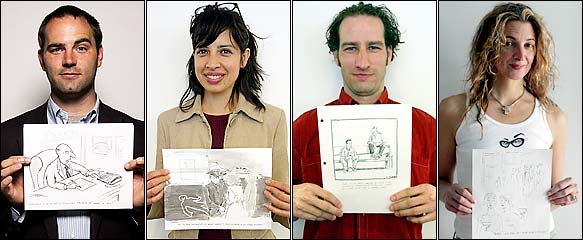Here’s an interesting article about the New Yorker. It seems the next generation of cartoonists at the New Yorker, a dozen or so, are all in their 30s. “Robert Mankoff, New Yorker cartoon editor and David Remnick, the editor of The New Yorker, are relying upon this group to keep alive the anachronistic but somehow indefatigable cultural institution of the classic single-panel New Yorker cartoon – known in the humor trade as the gag cartoon,” writes Warren St. John in the New York Times. “Many of the magazine’s established cartoonists, like Sam Gross, J. B. Handelsman and Robert Weber, are in their 70’s and 80’s. While the magazine has updated its roster regularly over the years – Mr. Mankoff, a relatively young 59, for example, was hired as a cartoonist in 1977 – grooming new talent has taken on a new urgency because many aspiring humorists would prefer to work for hipper, more lucrative outlets, like television.”
This is a good article about the young artists, and it highlights how the cartoonists got their breaks and how they find their ideas. “There is no set method for recruiting cartoonists, Mr. Mankoff said. Mr. Diffee got in the door when he won a contest, sponsored by The New Yorker and the Algonquin Hotel, with a drawing of a couple in a hotel room, staring at the “Do Not Disturb” sign on the back of their doorknob.
“Oh, great,” the man says. “I guess we’re stuck in here.”
According to the article, Mankoff receives nearly 1,000 unsolicited cartoons a week, and he attempts to remain accessible. And bringing in new talent is not without tention. The New Yorker publishes between 18 and 20 cartoons a week, and pays only an average of $675 a cartoon, according to the article. Space and money taken up by the up-and-comers leaves little room for the old guard, writes, who are still popular with readers. Check out the article. It’s an interesting peak inside famous literary hallways.
St. John continues: “Mr. Lewis got his chance when he met Mr. Mankoff’s assistant on a cigarette break in front of The New Yorker’s old building on 43rd Street, also the offices of Martha Stewart Living, where he was working as a designer of garden tools. Emily Richards, 34, a fact checker at the magazine who has published a single cartoon there, was discovered when Mr. Mankoff absent-mindedly picked up a folder of her sketches in the office.”
Another excerpt from the article: “While younger New Yorker cartoonists are not above a good lawyer or cat joke, their work typically contains more references to drugs, sex, e-mail and contemporary social mores. The cartoons of Chad Darbyshire, 32, who signs his cartoons C. Covert Darbyshire, for example, often deal with the stresses of contemporary childhood. In one, a child opening a present before his suit clad father says, “Tell your assistant it’s perfect.”






